US Blood Glucose Monitoring Market Size
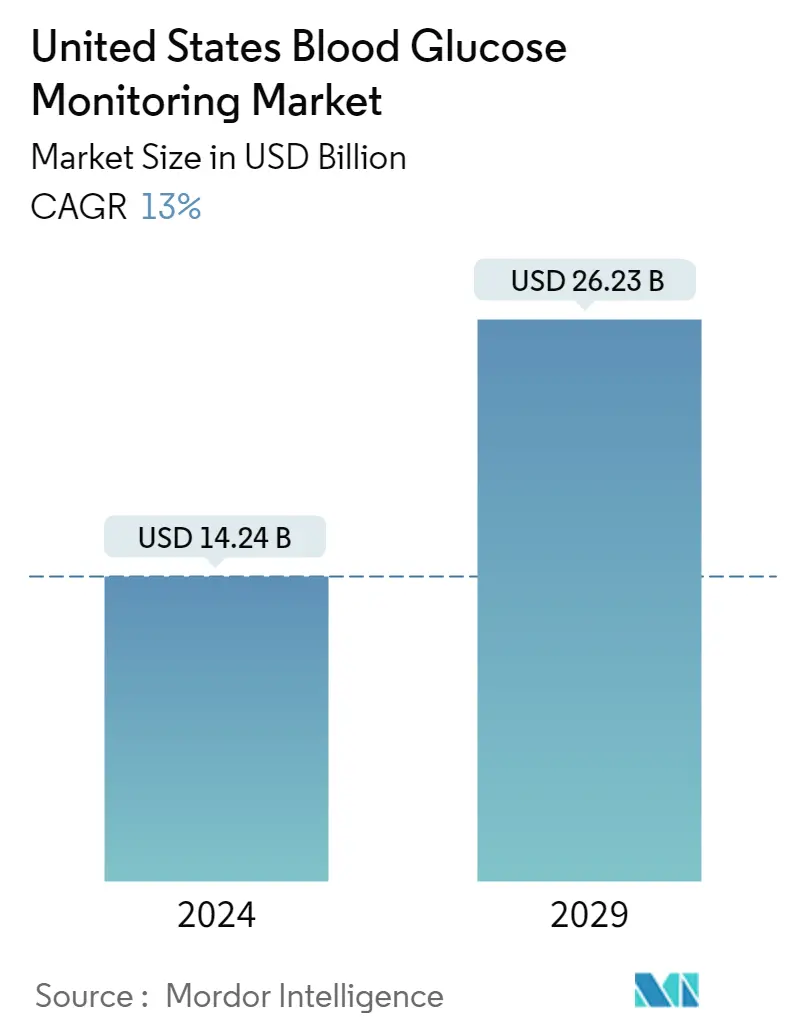
| Study Period | 2019 - 2029 |
| Base Year For Estimation | 2023 |
| Forecast Data Period | 2024 - 2029 |
| Market Size (2024) | USD 14.24 Billion |
| Market Size (2029) | USD 26.23 Billion |
| CAGR (2024 - 2029) | 13.00 % |
Major Players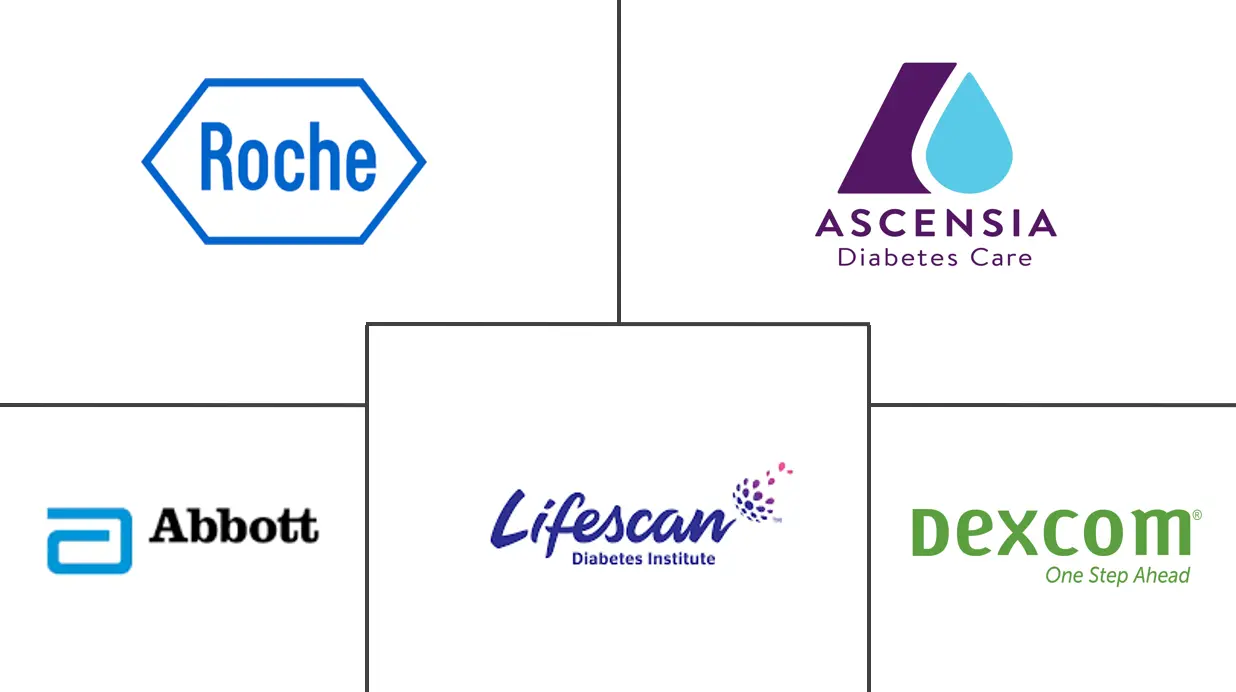
*Disclaimer: Major Players sorted in no particular order |
US Blood Glucose Monitoring Market Analysis
The United States Blood Glucose Monitoring Market size is estimated at USD 14.24 billion in 2024, and is expected to reach USD 26.23 billion by 2029, growing at a CAGR of 13% during the forecast period (2024-2029).
Diabetic patients were at a higher risk of hospitalizations and complications during the COVID-19 pandemic due to hyper- or hypoglycemia, metabolic comorbidities, and a more severe SARS-CoV-2 infection.The maintenance of euglycemia was important to decrease both morbidity and mortality in the hospital setting. According to experts, inpatient use of diabetes technology in patients with proper institutional protocols was safe, improved inpatient glycemic outcomes, and played a vital role in managing hypoglycemia and hyperglycemia in hospitalized patients.
Continued elevation in blood glucose levels in diabetes patients can contribute to progressive complications such as renal, nerve, and ocular damage. Blood glucose measurement helps find out how well blood glucose is being used and how well glucose is being controlled in the body.Over time, the readings provide the patient and their health professionals with the information required to determine the best management strategy for diabetes. When blood glucose levels are too high or too low, they can be managed successfully, which keeps health problems related to diabetes to a minimum.
According to the National Center for Health Statistics, approximately 32.8% of adults aged 18 and over in the United States will be obese in 2021. In obese individuals, the fat cells in the body release pro-inflammatory chemicals, which may make the body less sensitive to the insulin it produces by disrupting the function of insulin-responsive cells. Thus, these individuals need external insulin shots and are obligated to use a blood glucose monitoring device, such as a glucometer.
Technological advancements in blood glucose meters, including cellular-connected devices that automatically upload SMBG data to secure cloud-based databases, allow for improved sharing and monitoring of SMBG data. Real-time monitoring of SMBG data presents opportunities to provide timely support to patients who are responsive to abnormal SMBG recordings. Such diabetes remote monitoring programs can give people with T2D who don't have it well under control the extra help they need to improve critical outcomes, which will help the market in the years to come.
US Blood Glucose Monitoring Market Trends
This section covers the major market trends shaping the US Blood Glucose Monitoring Market according to our research experts:
Rising Diabetes Prevalence in the United States
In the United States, the number of people with diabetes has gone up a lot in the last 20 years. This is due to the rise in obesity and changes in lifestyle due to less physical activity, unhealthy eating habits, and other things.
The CDC National Diabetes Statistics Report 2022 estimated that more than 130 million adults are living with diabetes or prediabetes in the United States. Type 2 diabetes is more common, and diabetes is more consequential among communities of color, those who live in rural areas, and those with less education, lower incomes, and lower health literacy.
The ADA, the Endocrine Society, the American College of Physicians, the American Academy of Pediatrics, the Society of General Internal Medicine, and the National Academy of Medicine published statements and issued calls to action to address SDOH at the individual, organizational, and policy levels. In 2021, the ADA also published a scientific review describing the associations between SDOH and diabetes risk and outcomes, focusing on socioeconomic status, health literacy, the food environment, food insecurity, and neighborhood and physical environments, among other topics.
In the United States, there are several innovations in diabetes management platforms by startups, like Glooko, OneDrop, Verily, Vacate, Insulet, Noom, Bigfoot Biomedical, Virta Health, Diabeloop, and Orgenesis, which have launched in the market. The growing awareness among people regarding advanced diabetes devices is improving the adaptability of blood glucose monitoring devices. Leading manufacturers are focusing on technological innovations and developing advanced products to gain a substantial market share.
In May 2021, the World Health Assembly agreed on a resolution on strengthening the prevention and control of diabetes. It recommends action in areas including increasing access to insulin and promoting convergence and harmonization of regulatory requirements for insulin and other medicines and health products for the treatment of diabetes. In May 2022, the World Health Assembly endorsed five global diabetes coverage and treatment targets to be achieved by 2030.
Therefore, the studied market is anticipated to witness growth over the analysis period due to rising prevalence and the aforementioned factors.
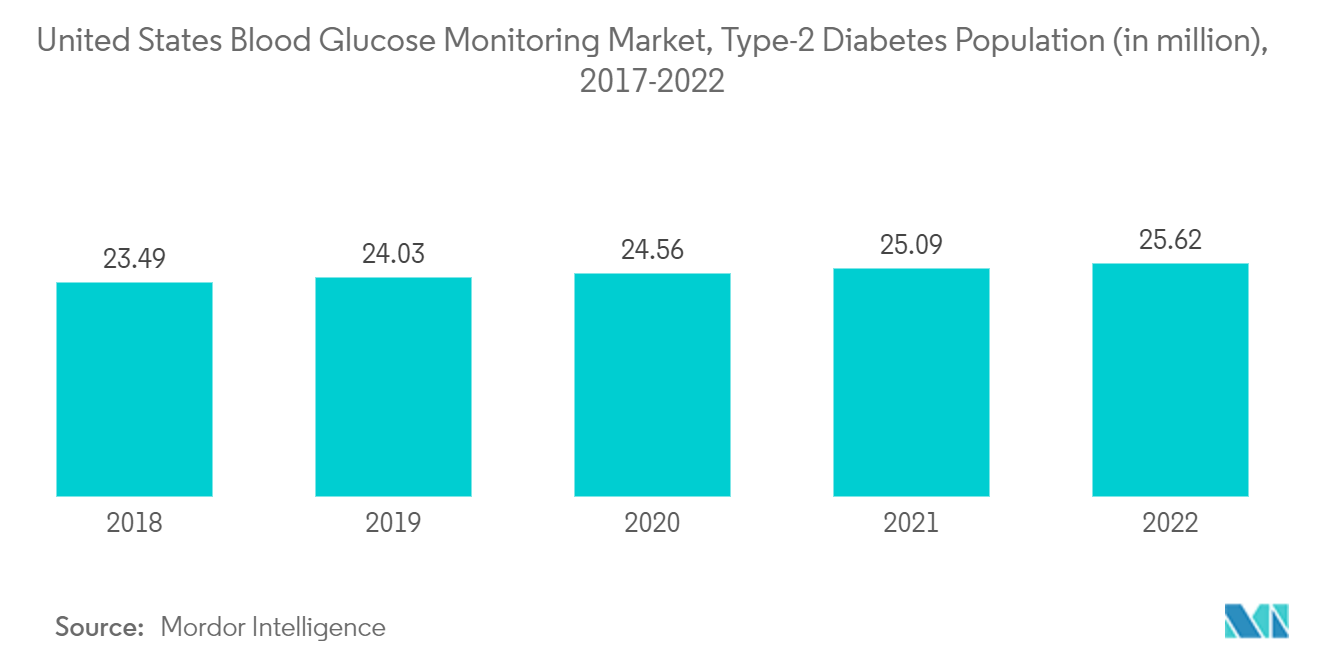
Continuous Glucose Monitoring Segment is Expected to Witness Highest Growth Rate Over the Forecast Period
During the forecast period, the Continuous Glucose Monitoring segment is expected to register a CAGR of more than 19%.
Continuous glucose monitoring sensors use glucose oxidase to detect blood sugar levels. Glucose oxidase converts glucose to hydrogen peroxidase, which reacts with the platinum inside the sensor, producing an electrical signal to be communicated to the transmitter. Sensors are the most important part of continuous glucose monitoring devices. Technological advancements to improve the accuracy of the sensors are expected to drive segment growth during the forecast period.
CGMs help patients better control their glucose levels because they can see their glucose levels in real time without having to do a fingerstick. The use of a CGM can also eliminate the need for fingerstick blood glucose monitoring.The use of CGM by type-1 diabetic patients is very low as compared to type-2 diabetic patients. But the expenditure incurred by type-1 diabetic patients on these devices is nearly double that of type-2 diabetics. People with Type-2 diabetes don't use CGM as much as they could because they are expensive and it's not clear how well they work or if they even need to.
Furthermore, the current continuous glucose monitoring devices can either retrospectively display the trends in the levels of blood glucose by downloading the data or give a real-time picture of glucose levels through receiver displays. In March 2022, Dexcom released G7 first in the U.K. and expanded the launch across Europe throughout 2022. The CGM system was under review by the Food and Drug Administration for an eventual U.S. release. The Dexcom G7 overcame many technical barriers, such as a short warm-up time, more accurate glucose readings, and a smaller size. Eversense E3 CGMs and other technological advances have made it much easier for doctors to treat diabetes and for patients to keep track of their blood sugar levels.
According to the Center for Health Care Strategies, for Medicaid agencies that can cover and increase access to CGMs for their beneficiaries and for the larger healthcare system, there is strong evidence that supports the benefits of CGM use for all people who are insulin-treated with an insulin pump or multiple daily insulin injections, and emerging evidence is showing the benefit of CGMs in patients on basal insulin.
The aforementioned factors are set to boost market growth.
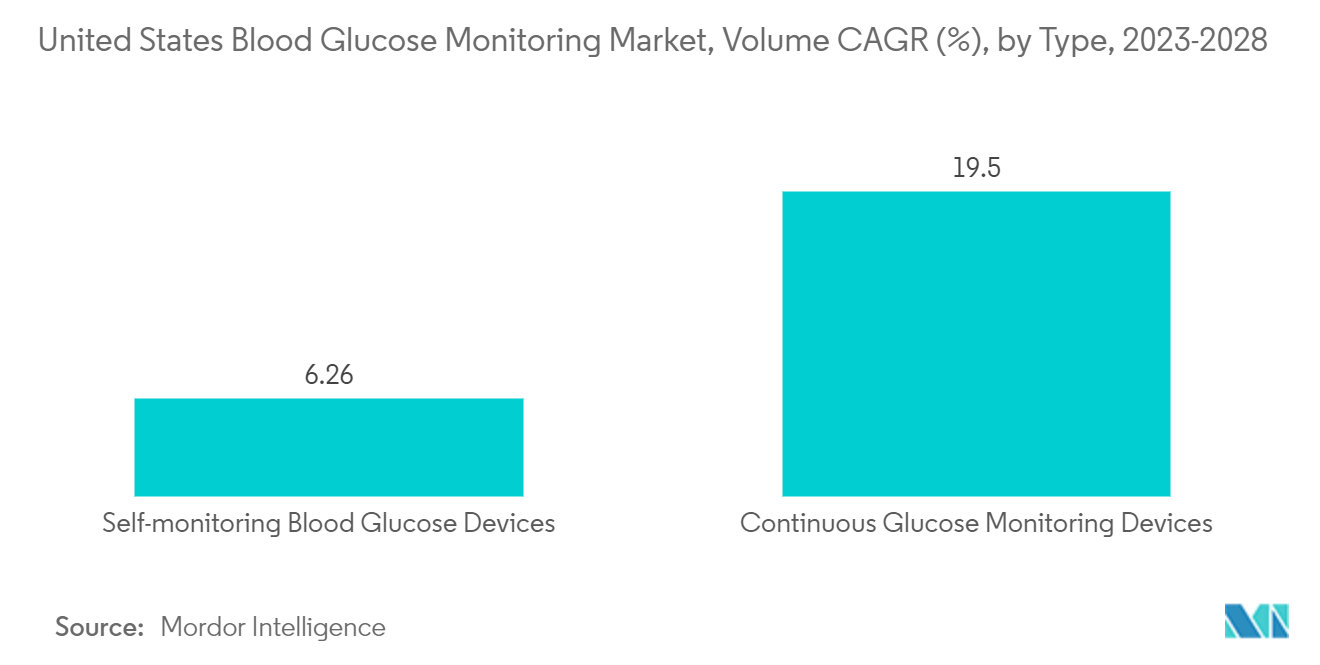
US Blood Glucose Monitoring Industry Overview
The United States Blood Glucose Monitoring Market is moderately fragmented, with few significant and generic players. The mergers and acquisitions between the players, like the acquisition of TypeZero Technologies by Dexcom, have sent Dexcom ahead on its way in the race to create an artificial pancreas system rather than merely offering a boost to the continuous glucose monitoring devices market. There have been constant innovations driven by manufacturers such as Abbott and Medtronic while also adhering to organic growth strategies, which is evident from the R&D spending of these companies.
US Blood Glucose Monitoring Market Leaders
-
Abbott Diabetes Care
-
Dexcom Inc.
-
Lifescan
-
Roche Holding AG
-
Ascensia Diabetes Care
*Disclaimer: Major Players sorted in no particular order
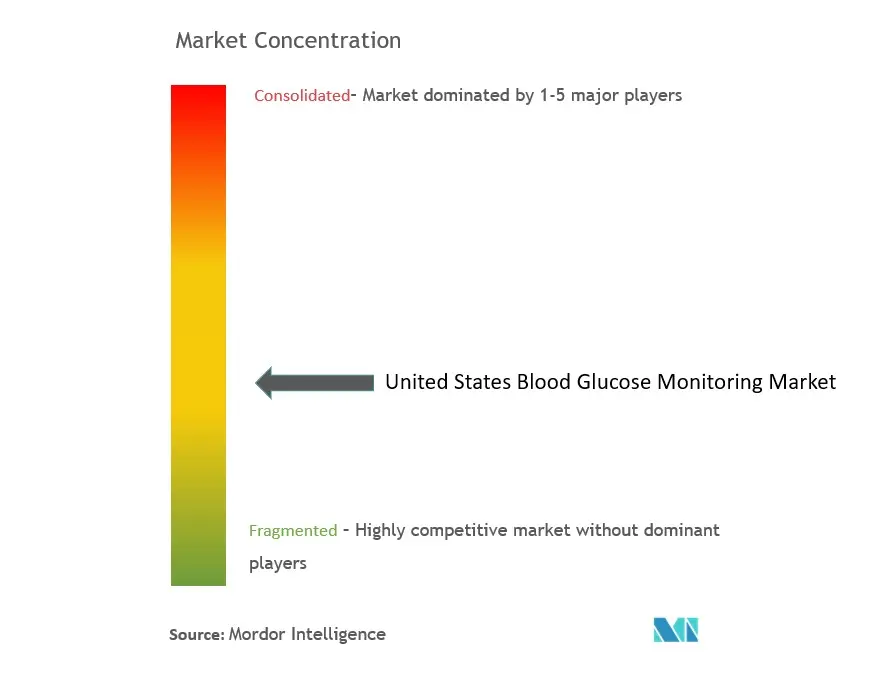
US Blood Glucose Monitoring Market News
December 20, 2022: Dexcom announced FDA approval for their next-generation product, the Dexcom G7 CGM. The G7 is approved for people with all types of diabetes, ages two and older.
October, 2022: Abbott announced that the Freestyle Libre 3 is now available in pharmacies nationwide after it received FDA clearance in May 2022.
US Blood Glucose Monitoring Market Report - Table of Contents
1. INTRODUCTION
- 1.1 Study Assumptions and Market Definition
- 1.2 Scope of the Study
2. RESEARCH METHODOLOGY
3. EXECUTIVE SUMMARY
4. MARKET DYNAMICS
- 4.1 Market Overview
- 4.2 Drivers
- 4.3 Restraints
-
4.4 Porter's Five Forces Analysis
- 4.4.1 Bargaining Power of Suppliers
- 4.4.2 Bargaining Power of Consumers
- 4.4.3 Threat of New Entrants
- 4.4.4 Threat of Substitute Products and Services
- 4.4.5 Intensity of Competitive Rivalry
5. MARKET SEGMENTATION
-
5.1 Self-monitoring blood glucose devices (Value and Volume, 2017 - 2028)
- 5.1.1 Glucometer Devices
- 5.1.2 Test Strips
- 5.1.3 Lancets
-
5.2 Continuous blood glucose monitoring devices (Value and Volume, 2017 - 2028)
- 5.2.1 Sensors
- 5.2.2 Durables (Receivers and Transmitters)
6. MARKET INDICATORS
- 6.1 Type-1 Diabetes population (2017 - 2028)
- 6.2 Type-2 Diabetes population (2017 - 2028)
7. COMPETITIVE LANDSCAPE
-
7.1 COMPANY PROFILES
- 7.1.1 Abbott Diabetes Care
- 7.1.2 Roche Holding AG
- 7.1.3 LifeScan
- 7.1.4 Dexcom Inc.
- 7.1.5 Medtronic PLC
- 7.1.6 Arkray Inc.
- 7.1.7 Ascensia Diabetes Care
- 7.1.8 Agamatrix Inc.
- 7.1.9 Bionime Corporation
- 7.1.10 Acon Laboratories Inc.
- 7.1.11 Trivida Functional Medicine
- 7.1.12 Rossmax International Ltd.
- 7.1.13 Senseonics
- *List Not Exhaustive
-
7.2 COMPANY SHARE ANALYSIS
- 7.2.1 Self-monitoring Blood Glucose Devices
- 7.2.1.1 Abbott Diabetes Care
- 7.2.1.2 Roche Holding AG
- 7.2.1.3 Other Company Share Analyses
- 7.2.2 Continuous Glucose Monitoring Devices
- 7.2.2.1 Dexcom Inc.
- 7.2.2.2 Medtronic PLC
- 7.2.2.3 Abbott Diabetes Care
- 7.2.2.4 Other Continuous Glucose Monitoring Devices
8. MARKET OPPORTUNITIES AND FUTURE TRENDS
** Subject To AvailablityUS Blood Glucose Monitoring Industry Segmentation
Blood glucose monitoring tests the concentration of glucose in the blood (glycemia). Particularly important in diabetes management, a blood glucose test is typically performed to determine the fluctuation in blood glucose level and to take or alter the medication accordingly, especially for insulin users. Achieving optimum glycemic results can be very difficult without frequent monitoring of blood glucose levels. The United States blood glucose monitoring market is segmented by type (self-monitoring blood glucose devices and continuous blood glucose monitoring devices) and components (glucometer devices, test strips, lancets, sensors, and durables). The report offers the value (in USD million) and volume (in unit million) for the above segments.
| Self-monitoring blood glucose devices (Value and Volume, 2017 - 2028) | Glucometer Devices |
| Test Strips | |
| Lancets | |
| Continuous blood glucose monitoring devices (Value and Volume, 2017 - 2028) | Sensors |
| Durables (Receivers and Transmitters) |
US Blood Glucose Monitoring Market Research FAQs
How big is the United States Blood Glucose Monitoring Market?
The United States Blood Glucose Monitoring Market size is expected to reach USD 14.24 billion in 2024 and grow at a CAGR of 13% to reach USD 26.23 billion by 2029.
What is the current United States Blood Glucose Monitoring Market size?
In 2024, the United States Blood Glucose Monitoring Market size is expected to reach USD 14.24 billion.
Who are the key players in United States Blood Glucose Monitoring Market?
Abbott Diabetes Care, Dexcom Inc., Lifescan, Roche Holding AG and Ascensia Diabetes Care are the major companies operating in the United States Blood Glucose Monitoring Market.
What years does this United States Blood Glucose Monitoring Market cover, and what was the market size in 2023?
In 2023, the United States Blood Glucose Monitoring Market size was estimated at USD 12.60 billion. The report covers the United States Blood Glucose Monitoring Market historical market size for years: 2019, 2020, 2021, 2022 and 2023. The report also forecasts the United States Blood Glucose Monitoring Market size for years: 2024, 2025, 2026, 2027, 2028 and 2029.
US Blood Glucose Monitoring Industry Report
The report covers the United States Blood Glucose Monitoring Market Outlook and is segmented into Type (Self-monitoring Blood Glucose Devices and Continuous Glucose Monitoring Devices) and Components (Glucometer Devices, Test Strips, Lancets, Sensors, and Durables). The report offers the value and volume for the above segments. Statistics for the US Blood Glucose Monitoring market share, size, and revenue growth rate are created by Mordor Intelligence™ Industry Reports.
The report provides a comprehensive industry analysis and a detailed industry outlook. It includes market data and market segmentation to highlight different components and types of blood glucose monitoring devices. The market overview offers insights into the current market trends and market growth, while the market forecast provides predictions for future market value and industry sales.
Additionally, the report includes industry information and industry research to support the analysis. The market review covers historical data and future prospects, giving a complete market outlook. The industry statistics and industry reports offer an in-depth look at market leaders and their market share.
The report example and report pdf download are available for further industry research. This industry overview is crucial for understanding market size and market growth, helping research companies and stakeholders to make informed decisions. The market predictions and market segmentation provide a detailed look at the market trends and industry trends shaping the future of blood glucose monitoring in the United States.



